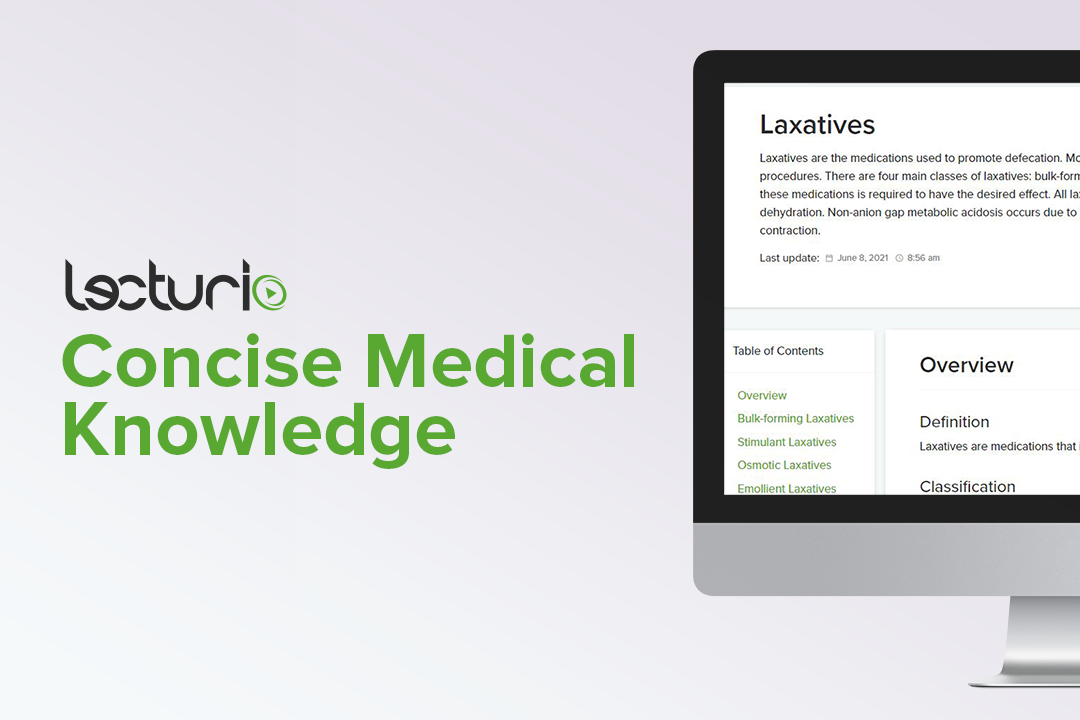Playlist
Show Playlist
Hide Playlist
Motility Disorder Medication
-
Slides Gastrointestinal Drugs.pdf
-
Download Lecture Overview
00:01 Let's move on to the motility disorders. So the motility disorders can be treated by several agents. 00:07 You have the dopamine antagonists, the motilin agonists, the laxatives, and the anti-diarrheal agents. 00:16 Let's start off with the cholinomimetics. So cholinomimetics increase the sphincter tone of the lower esophageal sphincter. 00:23 Now, in the past, we used drugs like bethanechol but not any more because bethanechol tends to be a toxic agent and doesn't really work as well as we had hoped. 00:34 Neostigmine which is an acetylcholinesterase inhibitor is often used in the hospital for acute bowel distention. 00:43 Now for further information on this particular agent, I encourage you to take a look at our autonomic nervous system pharmacology lectures, you'll have a much better discussion about this particular drug in that lecture. 00:56 Other agents include the dopamine receptor antagonists, specifically the D2 receptors. 01:02 So, metoclopramide is your prototypical example of this. It causes D2 blockade, and this causes increased bowel transit so things move a little bit quicker. They may also cause parkinsonian symptoms so you have to be fairly careful with these agents. They work also in the area postrema which is part of the emetic centre of the brain. 01:25 And for that reason, it's a very effective antiemetic in surgery and in cancer patients. 01:31 Domperidone is another example of this type of agents. It does not cross the blood brain barrier so it makes it a little bit different from metoclopramide. And it's therefore less likely to cause CNS effects. 01:44 Not surprisingly, the anti-emetic effects of domperidone are really not that significant. 01:49 Now, motilin receptor agonists are an interesting group because the prototypical agent is actually an antibiotic, erythromycin. 01:58 It directly stimulates motilin receptors and has benefits in patients with gastroparesis. 02:05 Now, this also explains the common side effect of diarrhoea. Erythromycin is hard on the system. 02:12 And most patients who take erythromycin for an infection complain of diarrhoea, and that's because of direct motilin receptor agonists activity. 02:21 Let's take a look at the laxatives. Now, laxatives can work in several different ways. 02:26 They can be bulk forming. So the classic example of that is psyllium. Now, psyllium is a seed and in order for it to work properly, it has to be chewed, and not just chewed but what we call masticated. And what we mean by that is that it has to be chewed and mixed with saliva because the salivary amylase will mixed with the psyllium and activate it. 02:48 Now, there are over-the-counter agents that are groud up psyllium. They come as an orange kind of a powder that you can spread on your eggs or mix with your orange juice. Those are actually quite effective. 03:01 Over-the-counter agents such as metamucil contain psyllium that has been activated. 03:06 Now, your herbalist naturapathic people like to give psyllium seeds directly, and that's fine, works really well as long as they chew it and masticate it, mix it with their saliva before they swallow. 03:19 It's gross. So I don't know why you'd ever want to choose to do that instead of just take metamucil. 03:25 There are stool-softening agents. Docusate sodium is a very commonly used agent. I use it in probably 60 % of my patients over the age of 80. 03:35 Glycerin tablets and glycerin suppositories and mineral oil is also another way of softening stool. 03:42 Now, osmotic cathartics work by actually causing more water to be present in the stool. 03:49 So, it's kind of like creating a gel matrix within the stool itself so that water stays in the stool, and that the stool is softer. Magnesium oxide and all of these other ones are examples of that. 04:00 Now, stimulants act by actually irritating the bowel. The prototypical and very old example of that is castor oil. 04:08 I'm sure you saw that on Bugs Bunny when you know they gave the coyote some stimulants and he had to go to the bathroom really quickly At least that's how I remember castor oil. It's not used anymore. 04:19 We now use things like aloe and senna which are probably more gentle and easier on the system. 04:27 Chloride channel activators are less used at this point in time. How they work is by increasing fluid bulk within the stool itself. 04:37 And finally, the opioid receptor antagonists are an interesting way of treating patients. 04:45 What happens is is that we know that opioids are constipating. By blocking the opioid receptor, we believe that this will reduce constipation, particularly in those patients who are on opioids. 04:59 So, there you have the list of the laxatives. Have a look at this. We're going to present this slide to you as a downloadable slide so that you can have this in your own slide library. 05:13 Let's take a look at some of these other agents now. I spoke to you before about opioids being constipating, we can actually use opioids as anti-diarrheal agents as well. 05:24 And that seems logical because opioids are constipating in and out themselves. 05:28 However, we don't want to use strong opioids and we actually have an agent that is a weak opioid, it's commonly sold as Imodium, it's a analogue of meperidine. It has minimal central nervous system effects and maximum GI effects. 05:46 Originally, when this agent was released on the market, we thought we would be using it for pain control, and the GI effects were so bad that people complain about it. But some enterprising scientist of the drug company said "Well why don't we use it for diarrhoea?" And actually it works really well. 06:02 So Imodium is probably the number 1 selling over-the-counter agent for the use in anti-diarrheal treatment. 06:12 Other anti-diarrheal agents include kaolin. So kaolin is a naturally found magnesium aluminum silicate. 06:19 And it's hydrated. So it works quite well. Pectin is an indigestable carbohydrate that comes from apples. 06:28 Now the interesting thing about pectin is that it actually absorbs bacterial toxins and some fluids. 06:33 So when you combine kaolin and pectin, you come up with an agent called Kaopectate which is sold commercially. 06:39 Now, this agent can of course cause constipation but when you giving your patient with diarrhea this agent, it works quite nicely. 06:46 Now the problem with Kaopectate is because it's one of these binders that binds toxin, if you think about it, it'll also interfere with the absorption of a whole host of medications. 06:57 So patients on Kaopectate, be aware that your other medications are probably being bound. 07:03 It's really important, I'm just going to stop here, and I'm going to say, do not use anti-diarrheal agents in patients who have bloody diarrhea or infectious diarrhea because the diarrhea in those cases are actually cathartic, in the truest sense of the word meaning that you're getting rid of the infectious agent and diarrhea in this case is a protective mechanism from the disease. 07:24 So, if you inhibit the protective mechanism, you may make the person much sicker. 07:29 We're going to cover this in more detail in your GI system's lecture by Lecturio later but I just want to put that out there now.
About the Lecture
The lecture Motility Disorder Medication by Pravin Shukle, MD is from the course Gastrointestinal Pharmacology.
Included Quiz Questions
What are the similarities and differences between metoclopramide and domperidone?
- Similarities: D2 receptor antagonists Differences: domperidone does not cross the blood-brain barrier
- Similarities: both are agonists Differences: domperidone cross the blood-brain barrier
- Similarities: neither is an antagonist Differences: domperidone does not cross the blood-brain barrier
- Similarities: both are enzyme inhibitors Differences: metoclopramide does not cross the blood-brain barrier
- Similarities: neither are enzyme inhibitors Differences: metoclopramide does not cross the blood-brain barrier
Which antibiotic can be used to treat motility disorders in the GI tract?
- Erythromycin
- Ampicillin
- Tobramycin
- Flonase
- Ceftriaxone
What is the mechanism of action of osmotic laxatives?
- Gel matrix that prevents water from GI absorption
- Increases the bulk of the stool to encourage stool passage
- A motility receptors agonist
- An opioid receptor antagonist
- Stimulates chloride channels
What is the mechanism of action for pectin?
- Absorbs bacterial toxins and fluids
- Excretes bacterial toxins
- Blocks calcium channels
- Stimulates calcium channels
- Forms a gel matrix around water
What is a warning to physicians regarding anti-diarrheal agents?
- Anti-diarrheal agents should not be used in bloody or infectious diarrhea.
- Anti-diarrheal agents are useful in all types of diarrhea.
- Anti-diarrheal agents should never be administered with a laxative.
- Anti-diarrheal agents should always be given with salt water.
- Anti-diarrheal agents should only be administered in a diarrhea emergency.
Customer reviews
5,0 of 5 stars
| 5 Stars |
|
1 |
| 4 Stars |
|
0 |
| 3 Stars |
|
0 |
| 2 Stars |
|
0 |
| 1 Star |
|
0 |
I understand everything that the doctor says and the class help me so much for my exams





